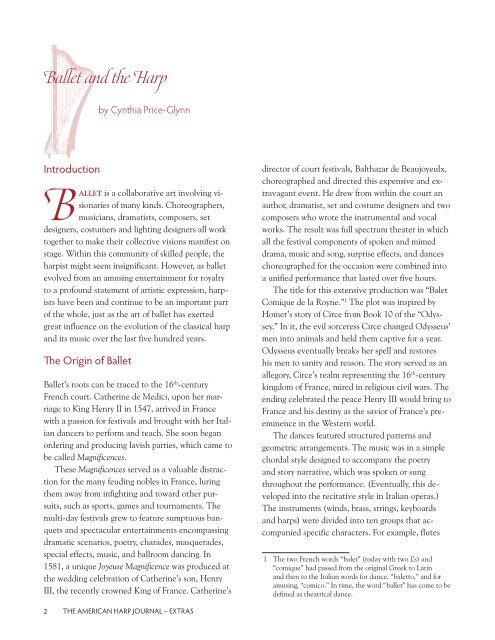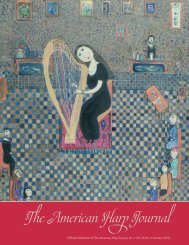The American Harp Journal - Extras - Summer 2017 (revised)
Supplement to Vol. 26 No. 1 (Summer 2017) of The American Harp Journal (revised)
Supplement to Vol. 26 No. 1 (Summer 2017) of The American Harp Journal (revised)
You also want an ePaper? Increase the reach of your titles
YUMPU automatically turns print PDFs into web optimized ePapers that Google loves.
Ballet and the <strong>Harp</strong><br />
by Cynthia Price-Glynn<br />
Introduction<br />
BALLET is a collaborative art involving visionaries<br />
of many kinds. Choreographers,<br />
musicians, dramatists, composers, set<br />
designers, costumers and lighting designers all work<br />
together to make their collective visions manifest on<br />
stage. Within this community of skilled people, the<br />
harpist might seem insignificant. However, as ballet<br />
evolved from an amusing entertainment for royalty<br />
to a profound statement of artistic expression, harpists<br />
have been and continue to be an important part<br />
of the whole, just as the art of ballet has exerted<br />
great influence on the evolution of the classical harp<br />
and its music over the last five hundred years.<br />
<strong>The</strong> Origin of Ballet<br />
Ballet’s roots can be traced to the 16 th -century<br />
French court. Catherine de Medici, upon her marriage<br />
to King Henry II in 1547, arrived in France<br />
with a passion for festivals and brought with her Italian<br />
dancers to perform and teach. She soon began<br />
ordering and producing lavish parties, which came to<br />
be called Magnificences.<br />
<strong>The</strong>se Magnificences served as a valuable distraction<br />
for the many feuding nobles in France, luring<br />
them away from infighting and toward other pursuits,<br />
such as sports, games and tournaments. <strong>The</strong><br />
multi-day festivals grew to feature sumptuous banquets<br />
and spectacular entertainments encompassing<br />
dramatic scenarios, poetry, charades, masquerades,<br />
special effects, music, and ballroom dancing. In<br />
1581, a unique Joyeuse Magnificence was produced at<br />
the wedding celebration of Catherine’s son, Henry<br />
III, the recently crowned King of France. Catherine’s<br />
director of court festivals, Balthazar de Beaujoyeulx,<br />
choreographed and directed this expensive and extravagant<br />
event. He drew from within the court an<br />
author, dramatist, set and costume designers and two<br />
composers who wrote the instrumental and vocal<br />
works. <strong>The</strong> result was full spectrum theater in which<br />
all the festival components of spoken and mimed<br />
drama, music and song, surprise effects, and dances<br />
choreographed for the occasion were combined into<br />
a unified performance that lasted over five hours.<br />
<strong>The</strong> title for this extensive production was “Balet<br />
Comique de la Royne.” 1 <strong>The</strong> plot was inspired by<br />
Homer’s story of Circe from Book 10 of the “Odyssey.”<br />
In it, the evil sorceress Circe changed Odysseus’<br />
men into animals and held them captive for a year.<br />
Odysseus eventually breaks her spell and restores<br />
his men to sanity and reason. <strong>The</strong> story served as an<br />
allegory, Circe’s realm representing the 16 th -century<br />
kingdom of France, mired in religious civil wars. <strong>The</strong><br />
ending celebrated the peace Henry III would bring to<br />
France and his destiny as the savior of France’s preeminence<br />
in the Western world.<br />
<strong>The</strong> dances featured structured patterns and<br />
geometric arrangements. <strong>The</strong> music was in a simple<br />
chordal style designed to accompany the poetry<br />
and story narrative, which was spoken or sung<br />
throughout the performance. (Eventually, this developed<br />
into the recitative style in Italian operas.)<br />
<strong>The</strong> instruments (winds, brass, strings, keyboards<br />
and harps) were divided into ten groups that accompanied<br />
specific characters. For example, flutes<br />
1 <strong>The</strong> two French words “balet” (today with two L’s) and<br />
“comique” had passed from the original Greek to Latin<br />
and then to the Italian words for dance, “baletto,” and for<br />
amusing, “comico.” In time, the word “ballet” has come to be<br />
defined as theatrical dance.<br />
2 THE AMERICAN HARP JOURNAL – EXTRAS




